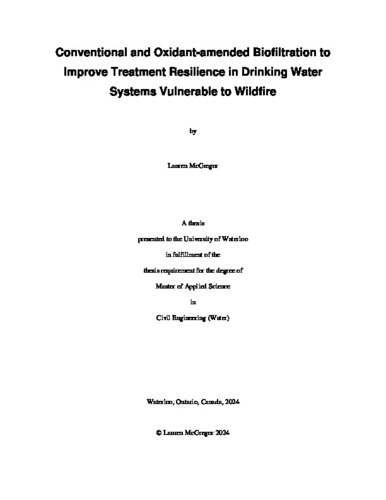| dc.description.abstract | Climate-change-exacerbated landscape disturbances can create obstacles for the provision of safe drinking water. The threats posed by wildfires are of particular concern due not only to the potentially extreme nature of their effects, but also because millions of people worldwide depend on water sourced from forested watersheds. Wildfire may lead to major shifts in the concentration and character of dissolved organic carbon (DOC), which may impair drinking water treatment processes to the point of causing service disruptions or outages. Resource-limited small systems can be especially vulnerable to variable water quality, underscoring a need for wildfire-resilient treatment strategies that are cost-effective and less operationally demanding than conventional processes. Biofiltration technologies—especially slow sand filtration—have been proposed as sustainable, low-cost strategies to remove DOC; however, their effectiveness has not been thoroughly investigated during periods of extreme source water quality change such as the episodic deteriorations possible following severe wildfire. Despite the operational simplicity of biofiltration, it is often described as a “black box” process due to our limited knowledge of its biological treatment mechanisms. A better understanding of biofiltration response to wildfire-associated source water disturbances at both the treatment performance and microbial community levels may increase the adaptability of biofiltration processes to climate change effects. Furthermore, biofiltration enhancement is an emerging area of research focused on the customization of biofiltration processes through exerting greater control at the design, process, and influent stream levels. Potential benefits include increased biodegradation of organics and lower incidences of hydraulic challenges. For many of these strategies, there has been little investigation in slow sand filtration. This work aims to advance knowledge in these areas through the execution of two main objectives: 1) assess DOC removal capacity in conventional and peroxide-amended biological sand filters when treating wildfire-ash-impacted water at bench-scale, and 2) evaluate the impacts of wildfire-associated disturbances and peroxide exposure on biofilter bacterial communities. Challenge testing with severely wildfire-ash-impacted water was conducted on biofilters operated in duplicate under conditions closely resembling slow sand filtration. Filters were subjected to two-, four-, and seven-day disturbance periods, each followed by a five-day return to “baseline” source water quality. One of these pairs, as well as another pair not undergoing ash challenge testing, received intermittent low-dose hydrogen peroxide amendment. Effluent DOC concentrations were elevated, and DOC removal declined during challenge periods; however, DOC characterization analysis showed this was likely the result of a higher proportion of slowly biodegradable humic and aromatic organic matter in the ash-impacted water. No significant evidence of impairment to biodegradation was observed. Biofilter performance was consistent within each disturbance period and recovered within hours of the return to baseline conditions. Over the 30-day experimental phase, the impacts of hydrogen peroxide amendment on organic matter accumulation and DOC removal were not significant to practice. Amplicon sequencing was carried out on filter media samples collected throughout the experimental phase. Community composition and diversity were compared across experimental conditions and were assessed alongside biofilter performance to identify potential connections. DNA sequencing was also conducted on media samples collected from a similar set of biological sand filters in a previous ash challenge experiment, which used a distinctly different source water. The lack of compositional differences between microbial communities in filters under different experimental conditions supported the assertion that ash-impacted water and peroxide amendment did not severely disrupt the biological communities in the long-term. Comparison of the two filter sets, however, demonstrated the significant impact of source water character on biological filter community characteristics and dynamics. Collectively, the two components of this work provided process insights into biofilter disturbance response and resilience from multiple perspectives. | en |

